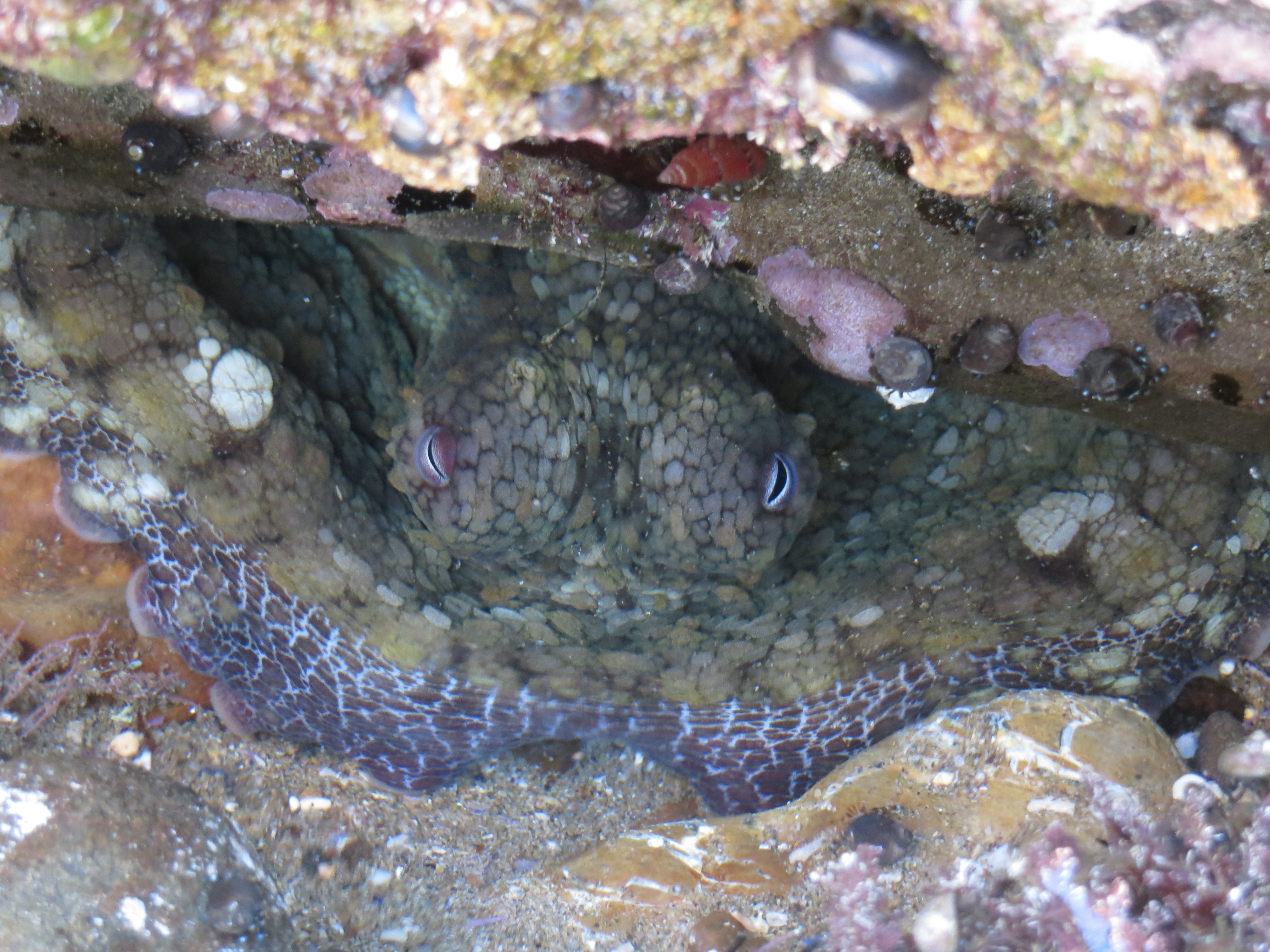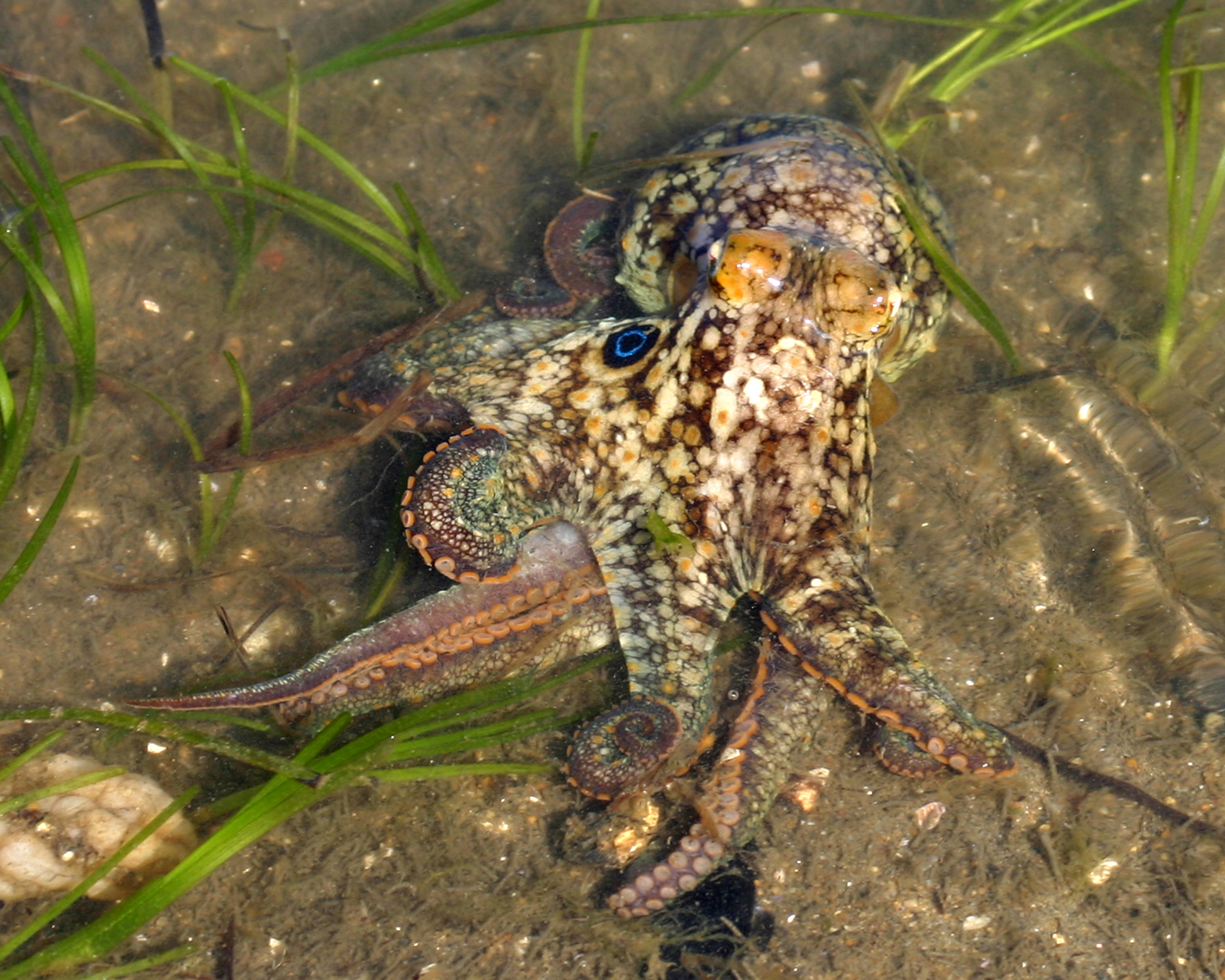The Science

Taxonomic description
- As with other octopi, this octopus is a soft bodied mollusk with eight tentacles. [3]
- Distinguished by two bright blue spots on either side of its body that resemble eyes, thought to be an adaptation to ward off predators. [3]
- Has a mottled brown color, but like its relatives, it can change skin color and texture when hunting, hiding, mating, or responding to other stimuli. [3]
- Average size is 45cm (18in) long, a smaller species compared to its counterparts. [3]
Distribution
- Pacific Ocean along the coast from Northern California to Baja California, Mexico. [3]
Life history
- Life span: 1-1.5 years in the wild, up to 2 years in captivity. [3]
- Matures quickly at the embryonic stage, emerging from the egg fully capable of hunting and feeding itself. [3]
- The California two-spot octopus grows indeterminately and reaches mating age between 1 and 2 years. [3]
- Semelparous (mates once in a lifetime) and can mate at any time during the year, although primarily during summer due to warmer water temperatures. [3]
- The male inseminates female using spermatophores and dies shortly after. [3]
- The fertilized female will lay an average of 70,000 eggs in a den and siphon cool water over the nest; female often dies during this period due to starvation and exhaustion. [3]
- Eggs hatch after a 150-210 day gestation period. [3]
Habitat
- Found in the intertidal and subtidal (up to 3 meters or 15 feet depth). [3]
- Prefers rocky reefs, canyon ledges or a habitat with small caves or holes in which it can den, and is known to inhabit abandoned pipes. [3]
- Highly developed eyes support its mostly nocturnal behavior. [3]
- Preys on smaller mollusks and crustaceans. [3]
- Predators include Moray eels, harbor seals, sea lions, and humans. [3]
The Fishery

Seasonal availability
- Available year round. [4]
Regulatory and managing authority
- As tit is caught as bycatch for the California spiny lobster fishery, it is managed by the California Department of Fish and Wildlife. [1,7]
- As it is not a commercially targeted species, there are currently no formal management plans in place but this fishery is monitored. [4,7]
Gear type
- Often caught in pots and mesh traps intended for crab and spiny lobster; hand capture. [5]
- No other gear targeting octopus is currently permitted by CDFW. [4]
Status of the fishery
- The fishery is at maximum sustainable yield and fishing effort should not increase (little enforcement of regulation). [5]
- Scientifically independent stock assessment is needed for more effective management, including data on long and short term trends in population abundance. [5]
- Currently has no special conservation status but studies about female gonadal development and juveniles suggest that a minimal catch size should be implemented. [5]
Potential ecosystem impacts
- Hand capture methods have minimal to no destruction of habitat, however traps have moderate effect on physical and biogenic habitats. [5]
- Removal of species can potentially impact the food web or ecosystem, as with any other top predator. [5]
- Susceptible to overfishing but also capable of rapid recovery. [5]
- Conservation concern is higher because this species range is limited to one coastline. [5]
The Seafood

Edible portions
- All of the meat and skin is edible, including tentacles; beak, eyes, innards, and ink sac are removed and discarded before consumption. [6]

Description of meat
- The long muscle fibers can make for tough, chewy meat if not properly tenderized or if overcooked. [6]
- The meat has a slightly sweet taste, similar to shellfish and squid. [6]
- Skin is colored and gelatinous, and the meat is white. [6]
Culinary uses
- Cooking time is short since species is small as to prevent the meat from becoming tough. [6]
- Usually blanched in wine or water to cook meat, then served hot on the grill or marinated cold for use in salads and ceviche. [6]
- Usually prepared with minimal seasonings such as lemon and herbs as to not overwhelm the light sweet flavor. [6]
- Versatile: recipes that use octopus include pastas, stews, soups, salads, and barbeque. [6]
- For a recipe for Korean spicy stir-fried octopus, visit Maangchi. [8]
Nutritional information
- Nutritional content for 100g serving of octopus is listed. [2]
- Meat is low in fat and high in protein and cholesterol. [2]
- Has healthy abundance of vitamins and minerals, especially iron, Vitamin B-12, and Selenium. [2]
Toxicity report
- None known. [2]
Seasonal availability
- It is available year round, but locally caught octopus is limited as it is a rarer seafood item.
References
[1] California Department of Fish and Wildlife. 2017. ‘Commercial Fishing Licenses’. Web. https://www.wildlife.ca.gov/Licensing/Commercial. Accessed: 21 May 2017
[2] Octopus. Web. Nutritionvalue.org. Accessed: 21 September 2017.
[3] Hamilton, B. Swope, L., 2013. ‘Octopus bimaculatus’. Web. http://animaldiversity.org/accounts/Octopus_bimaculatus . Accessed: 12 May 2017
[4] Major, D. 2017. Personal Communication. San Diego Commercial Fisherman, F/V Plan B, San Diego Bay, CA.
[5] Monterey Bay Aquarium Seafood Watch. 2007. ‘Gulf of California Seafood Report: Octopus’. Web. https://www.seachoice.org/wp-content/uploads/2012/01/MBA_SeafoodWatch_Gu.... Accessed: 18 May 2017
[6] Splendid Table. 2013. ‘Octopus Demystified’. Web. ‘https://www.splendidtable.org/story/octopus-demystified’. Accessed 18 May 2017.
[7] California Department of Fish and Wildlife. 2016. California Spiny Lobster Fishery Management Plan. Web. https://nrm.dfg.ca.gov/FileHandler.ashx?DocumentID=121938&inline. Accessed 24 November 2020.
[8] Maangchi. 2018. Spicy stir-fried octopus (Nakji-bokkeum). Web. https://www.maangchi.com/recipe/nakji-bokkeum. Accessed 12 January 2021.
[9] Vavra, J. flickr. 2007. a-O-bimaculoides. Digital image. Web. https://flickr.com/photos/43973579@N08/4204837425. Accessed 16 February 2021.
[10] tsoleau. flickr. 2015. California two-spot octopus. Digital image. Web. https://flickr.com/photos/23535767@N04/25237011152. Accessed 16 February 2021.
[11] sswj. flickr. 2010. Pillar Point Crab Pots (Color). Digital image. Web. https://flickr.com/photos/sswj40/22092086652. Accessed 16 February 2021.
[12] Boman, M. flickr. 2012. Octopus. Digital image. Web. https://flickr.com/photos/10384097@N08/6851284615. Accessed 16 February 2021.

